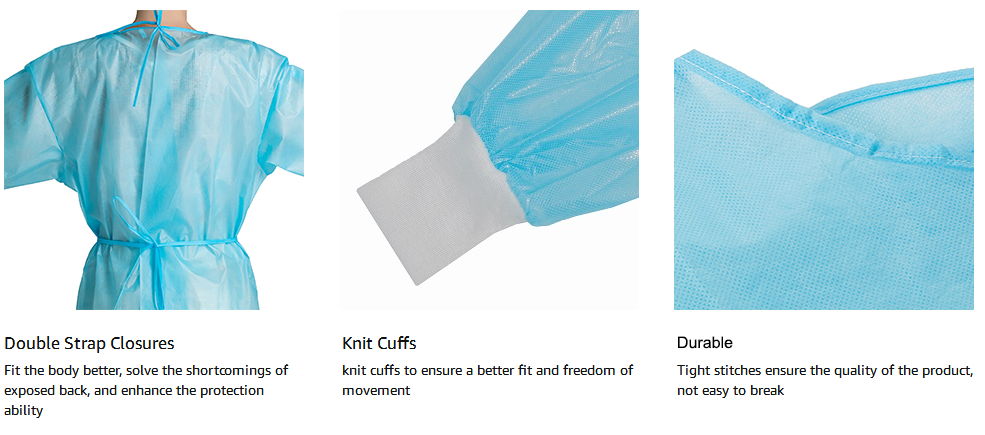WILLCOME Disposable isolation gown is a type of protective clothing worn by healthcare workers or patients to protect against the spread of infectious agents, such as bacteria, viruses, or other pathogens. It is made of non-woven materials, such as polypropylene or polyethylene, and is designed to be used once and then discarded. The isolation gown covers the entire body and typically has long sleeves, a neck tie closure, and a waist tie to keep the garment securely in place. Disposable isolation gowns are commonly used in hospitals, clinics, and other healthcare settings, as well as in research and laboratory settings, where there is a risk of exposure to infectious agents. They are an important part of infection control procedures and help to prevent the spread of diseases from person to person.



Breathable Material: The materials used in disposable isolation gowns are chosen to be breathable, ensuring comfort for the wearer during extended use.
Fluid Resistance: Disposable isolation gowns are made from materials that provide resistance to liquids and fluids, including blood, bodily fluids, and other potentially infectious substances. This helps prevent contamination of clothing and skin.
Non-Linting: Disposable isolation gowns are typically non-linting, reducing the risk of lint or particles contaminating sterile environments.

Open or Closed Back: Isolation gowns can have an open or closed-back design. Closed-back gowns provide more comprehensive coverage, while open-back gowns are easier to put on and take off.
Tie or Snap Closures: Isolation gowns may have tie closures or snap closures, allowing for secure fastening while ensuring ease of removal.
Elastic or Knitted Cuffs: Gowns may feature elastic cuffs or knitted cuffs at the wrists to provide a secure fit and prevent liquids from entering the sleeves.
Neck and Waist Ties: Many isolation gowns have neck and waist ties or closures to ensure a snug fit and prevent gaps that could expose the wearer to contaminants.
Various Sizes: Disposable isolation gowns come in Unisex design and various sizes to accommodate different body types and ensure a proper fit.

Full Coverage: Isolation gowns typically provide full coverage of the body, including the front, back, and arms, to protect the wearer from potential exposure to infectious agents.
Disposable Design: These gowns are intended for single-use and are disposed of after each use to prevent cross-contamination and maintain a sterile environment.
Resistance to Tears and Puncture: These gowns are designed to resist tears and punctures, ensuring their integrity during use.
Latex-Free: Many isolation gowns are latex-free to accommodate individuals with latex allergies.
Disposable and Biodegradable Materials: Some gowns are made from biodegradable materials or materials·designed to be eco-friendly,aligning with sustainability goals in healthcare
Product name | Disposable Isolation gown(Non-Sterile) |
Type | One piece style, Separated style, Reversible style |
Size: | S, M, L, XL, XXL, XXXL |
Material | PP, PP+PE, PE, SMS, CPE |
Weight | 25-50g/㎡ |
Color | Blue, Yellow, Green or customized |
Style | knitted cuff/Elastic cuff, Tie-on neckline/Velcro neckline, waist tie. |
Process | Sewing or ultrasonic sewing |

Polypropylene (PP):
Polypropylene is a versatile, breathable, and lightweight material.It provides a good barrier against fluids and particulate matter.(Optional)
SMS Fabric(SMS):
SMS fabric is a composite material made from different layers of spunbond polypropylene and meltblown polypropylene. (Optional)
Polyethylene Material(PE):
Polyethylene is a lightweight and waterproof material.It offers excellent fluid resistance.(Optional)
Polyethylene-Coated Material (PE coated)
Some gowns may feature a polyethylene-coated layer for additional protection.(Optional)
CPE (Chlorinated Polyethylene) - Optional
Chlorinated polyethylene shoe covers are made from a durable and water-resistant ·material. They offer a higher level of fluid resistance compared to standard polyethylene covers.

Used in Hospital and Clinic for Surgical Procedures, Dental Procedures and Minor surgery.

Isolation Precautions,Patient Care,Long-Term Care Facilities,Home Healthcare.

The lab is for research and development, for experiments, for testing.

Pharmaceutical companies wear gowns to make drugs, to keep them from splashing on the body

Food processing, production and testing to ensure food safety, pollution and dust prevention

Clean room Wear isolation clothes to keep yourself and the indoor health environment

1. Unpack and take out the isolation gown
2. While holding the upper edge, slide the upper limbs into the sleeves of the isolation gown.
3. Insert your hands into your sleeves and find the neckline

4. Fasten the upper free edges at the back with the Velcro tapes or ties making sure that they are overlapping generously.
5. Pull the free edges across the back of the body at waist level so that the right flap overlap the left flap to the side of the waist on the left.
6. Tie the waistband at the back to fasten the back flaps.
After use, unfasten the string and Velcro tapes and dispose of it properly.